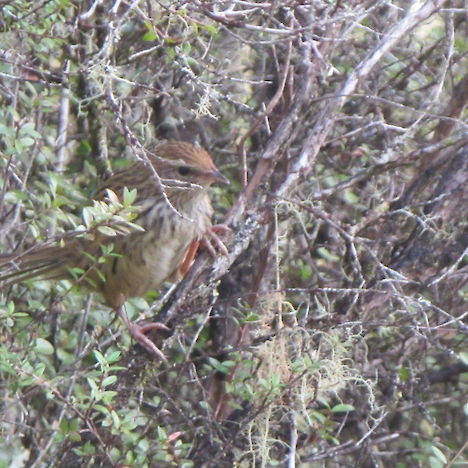Other names:
MātātāThreat category:
At Risk: Declining?Regions:
Northland, Auckland, Waikato, Bay of Plenty, Gisborne, Hawkes Bay, Manawatu-Wanganui, Taranaki, Nelson-Tasman, Marlborough, Westcoast, Otago, SouthlandDistribution:
Throughout most of New Zealand
Description
- Fernbirds are a little larger than sparrows, and are brown above and pale below, the body being strongly streaked and spotted dark brown.
- They are often seen rather than heard, the common call being a quick ‘tchip’.
Interesting Facts
- Fernbirds are only found in New Zealand. Each of the five subspecies is restricted to an island.
- Fernbirds are found through much of the North Island and the west and south of the South Island in a variety of different wetland types including drier wetlands (e.g. pakihi, tussock-covered areas, manuka scrub etc.)
- Fernbirds can occur in scrub long distances away from wetlands.
- The impact of introduced predators on fernbird is not well understood. However, they are known to have disappeared on some offshore islands off Stewart Island with the introduction of rats. Research has also implicated rats. Despite this, dense populations can exist in some wetlands.
Association with Plantations
- Fernbirds are found in young stands of exotic forest in the central North Island and Hawke’s Bay, and may be found in plantations elsewhere.
Threats
- Habitat loss and degradation from wetland drainage, loss of riparian margins, and the effects of surrounding landuse.
- Invasion of exotic plants, which can seriously modify wetlands and reduce suitability for birds.
- Disturbance and motor wash from recreational boats
- High predation rates, particularly of pateke, mainly from dogs, cats and mustelids.
- Mammalian predation may also affect some other wetland bird species, but the extent of the impacts is unknown.
Management Options and Methods
- Habitat protection:
- Protect important wetland habitats and riparian buffers.
- Avoid using herbicides or pesticides close to wetlands.
- Ensure weeds are not inadvertently introduced to wetlands, e.g. via machinery or boats.
- Consider control options for existing, invasive, wetland weeds.
- Consider a staged removal of willows to ensure ongoing cover for crakes and ducks.
- Forest operations:
- Minimise damage to riparian and wetland habitat during road construction and harvest operations.
- Avoid grazing wetlands and their margins. Fencing may be appropriate in some situations.
- Avoid diverting run-off into wetlands.
- Minimise disturbance during spring breeding.
- If pateke are present, discuss predator control with neighbours and DOC.
- Injured or dead wetland birds (particularly the more threatened species, i.e. white heron, bittern and pateke):
- Place injured birds in a cardboard box (keep shaded) and deliver to a local vet, SPCA, DOC.
- Call DOC if bird is dead.
Monitoring Options
- Increase staff and contractor knowledge about wetland birds.
- For important wetlands that are likely to have the more threatened species, consider undertaking a bird monitoring programme:
- Fernbirds, spotless crakes and to a lesser extent marsh crakes and banded rails can respond to taped playback calls.
- The booming calls of bittern are characteristic at dusk in September-October particularly during bright moonlight.
- Maintain a database of sightings.
Further Information and Support
- New Zealand Birds Online: fernbird.
- Department of Conservation website: fernbird.
- Wetland Restoration: A Handbook for New Zealand Freshwater Systems. Landcare Research - Manaaki Whenua.
- Pest management - Department of Conservation, Regional Councils.



